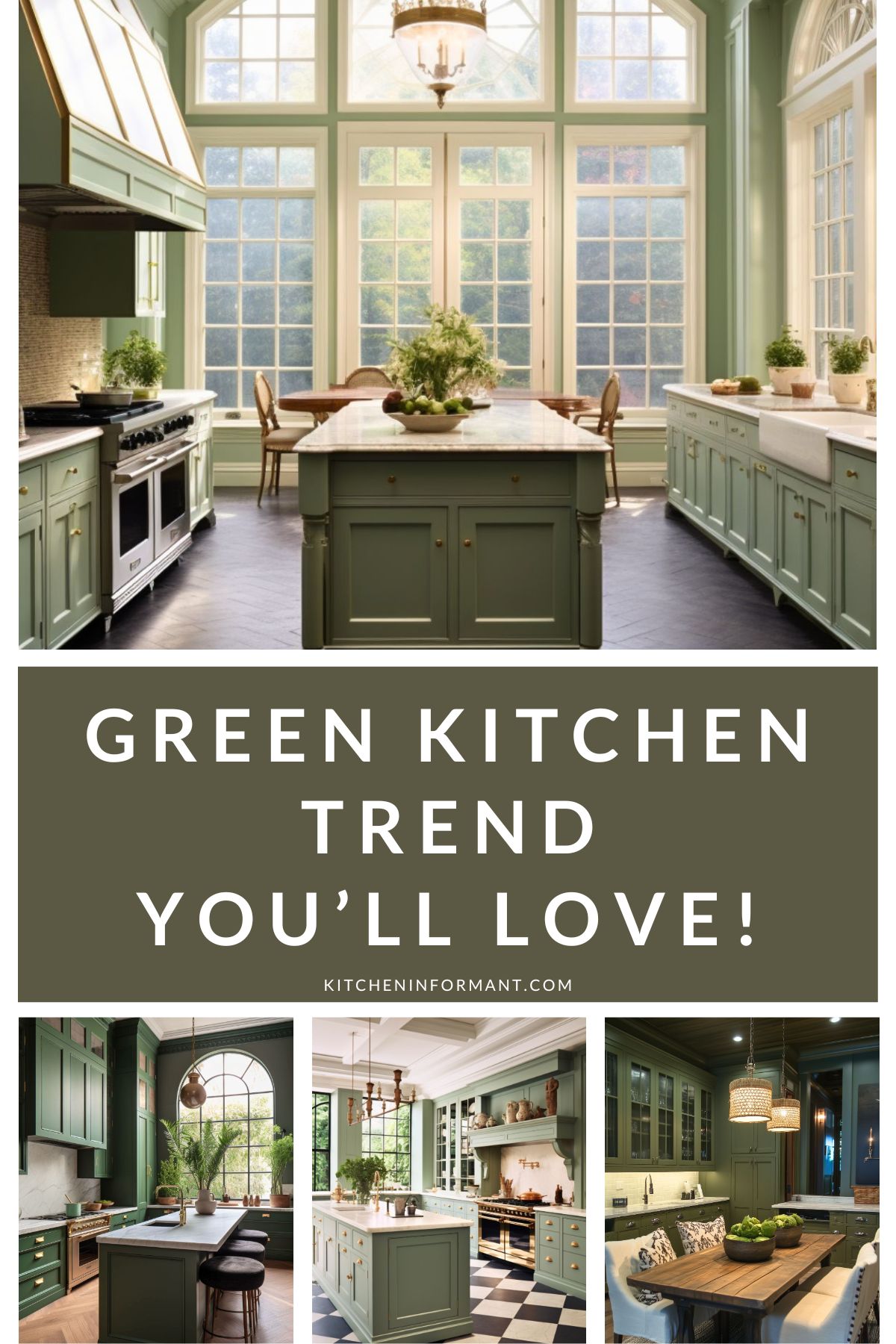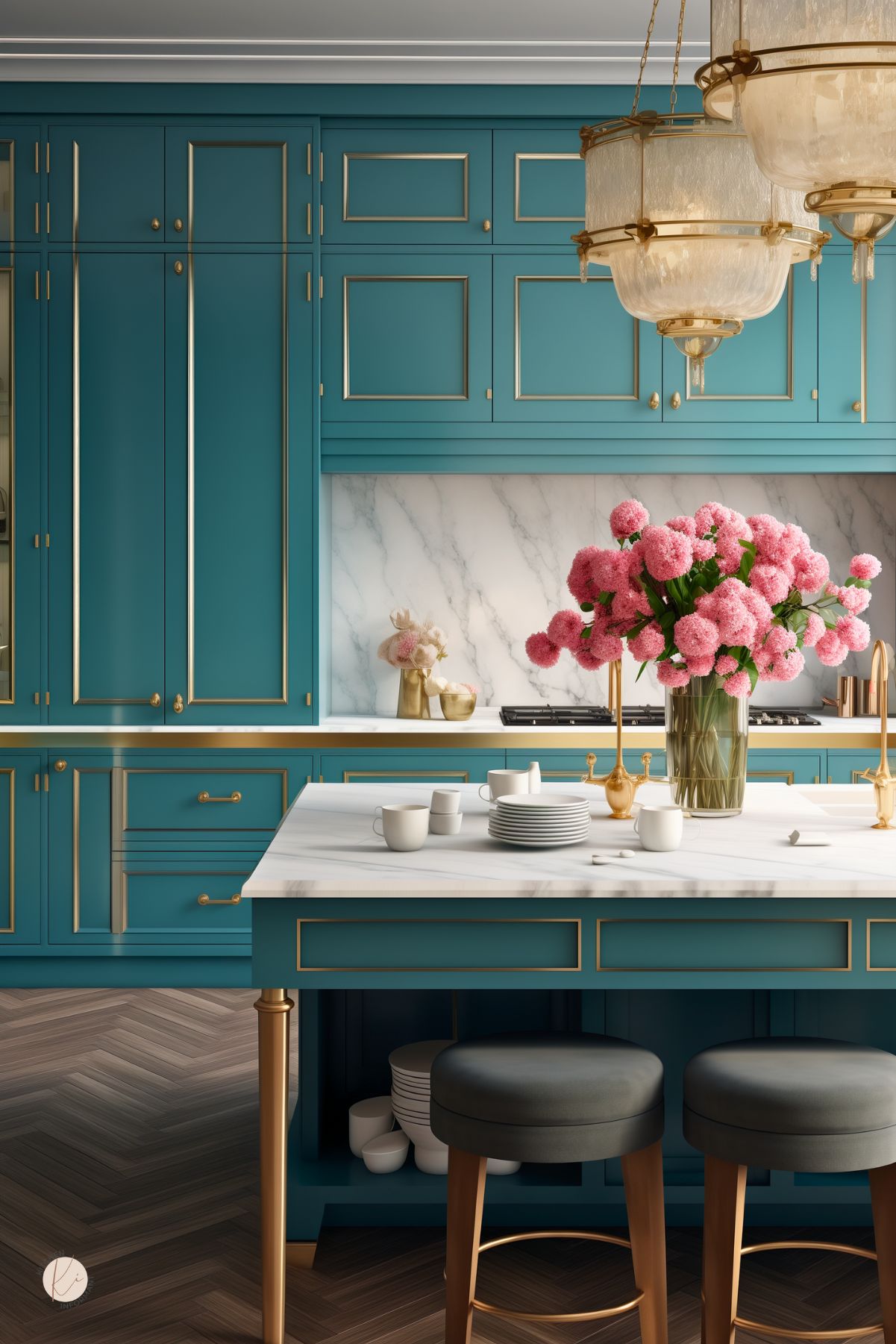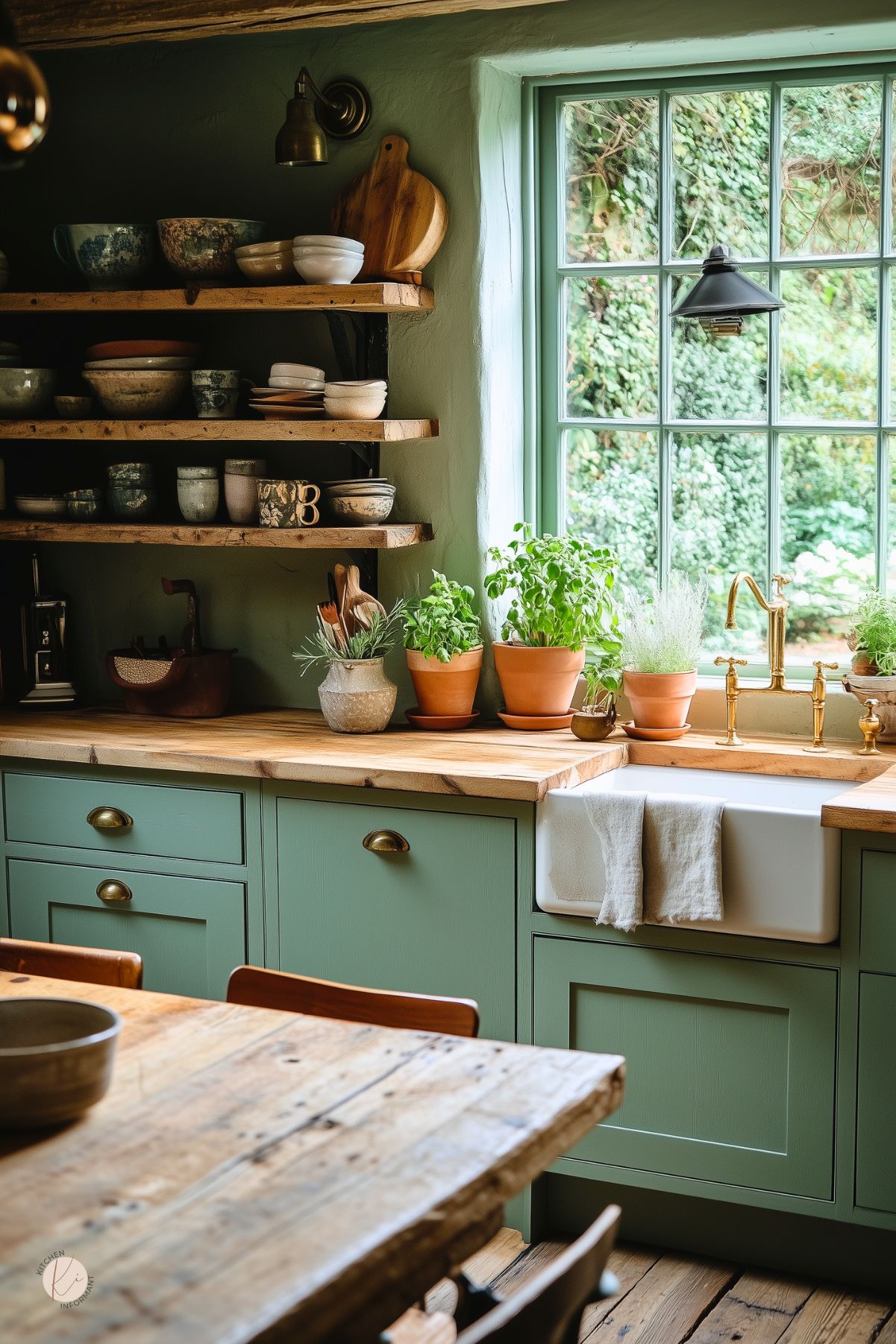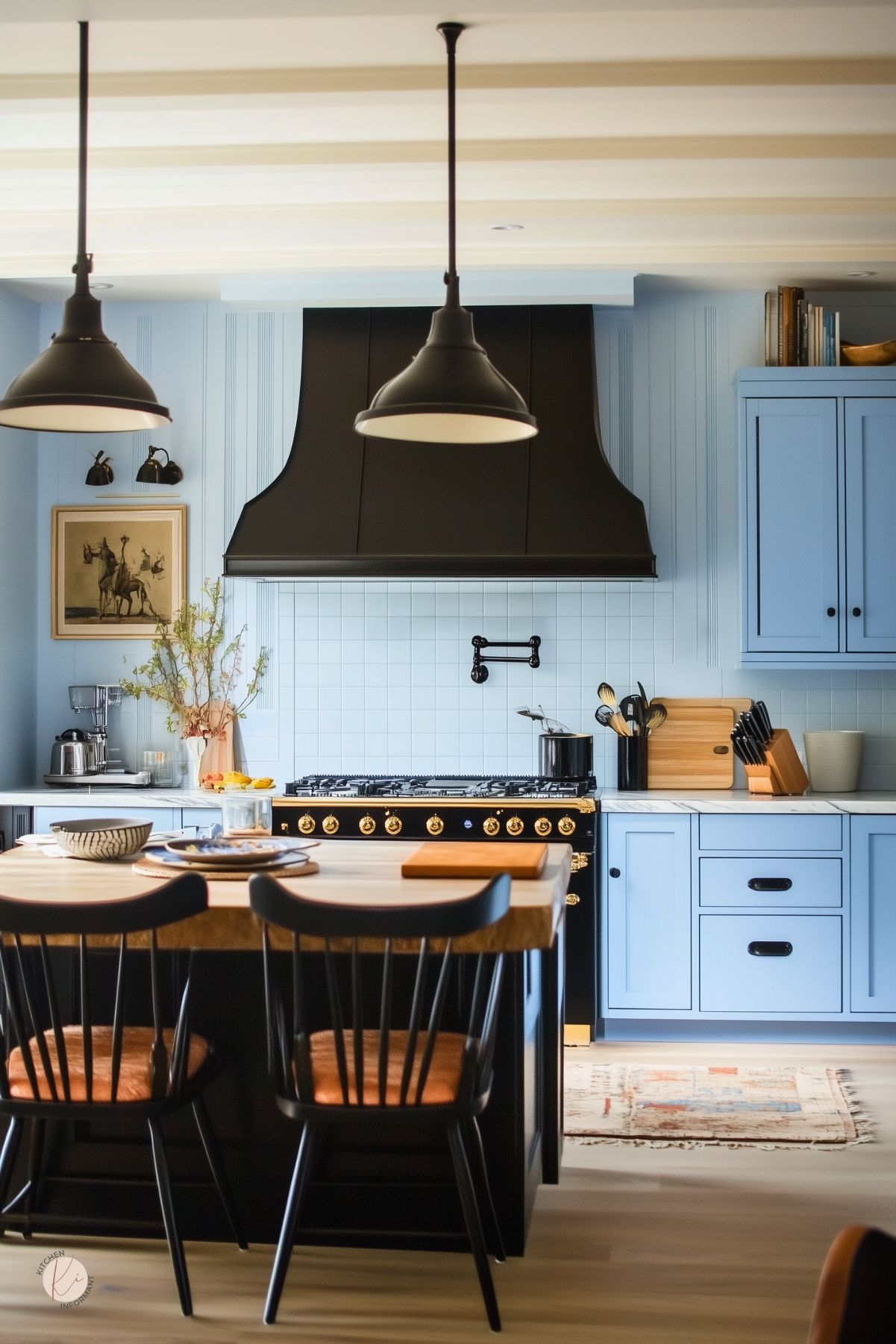Green kitchens are becoming a popular choice among homeowners looking to bring a fresh, natural feel into their homes. This color not only adds beauty but can also promote a calming atmosphere.
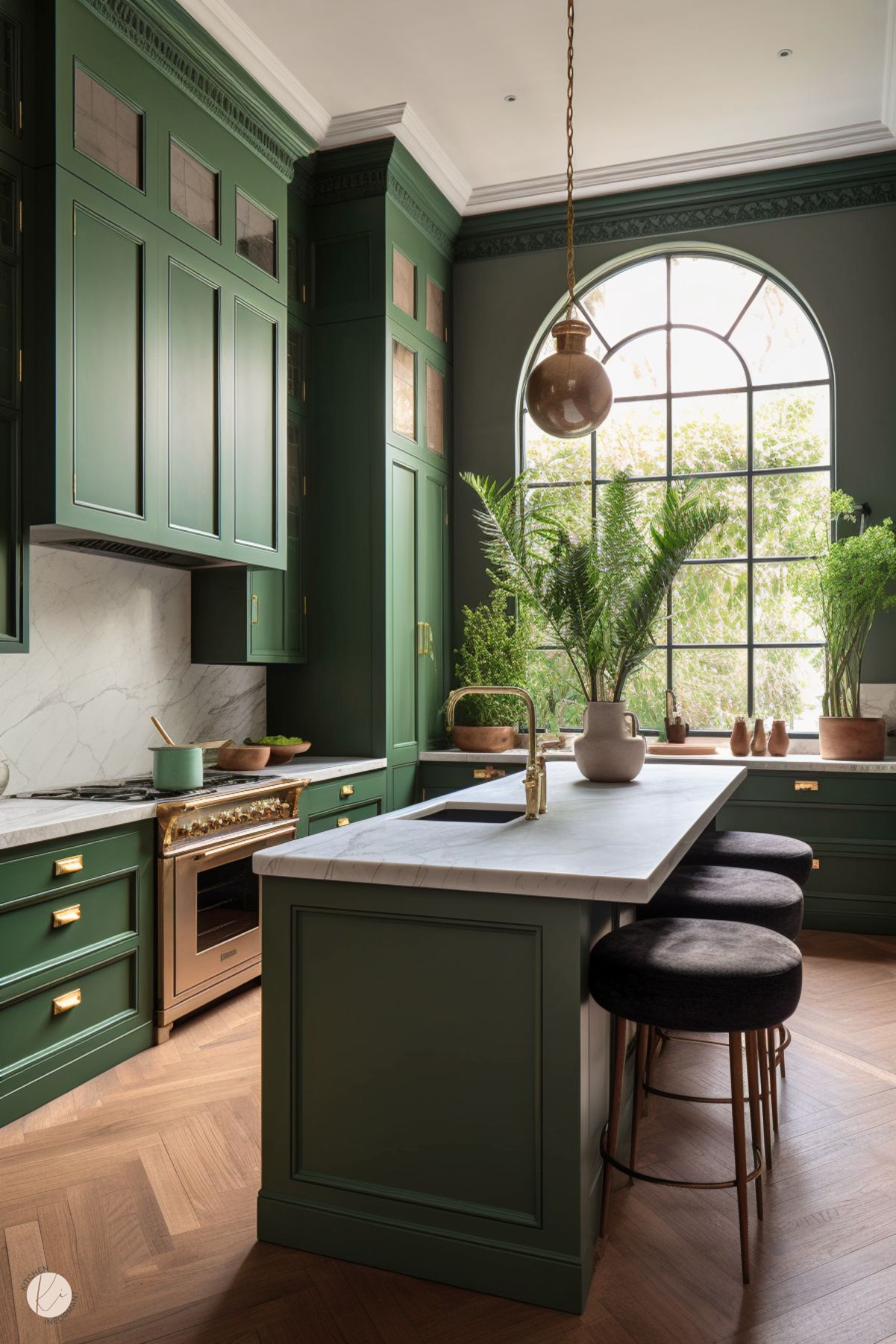
From soft sage to bold emerald, green offers a range of options that can make any kitchen feel inviting. The right shade can enhance natural light and make the room feel more spacious.
Many designers highlight how pairing green with neutral tones can further elevate the aesthetic, making it a versatile choice for anyone looking to update their kitchen.
With so many inspiring ideas available, it’s easy for anyone to find the perfect green for their kitchen.
By exploring different styles and color combinations, they can transform their cooking space into a beautiful retreat.
Understanding Green in Kitchen Design
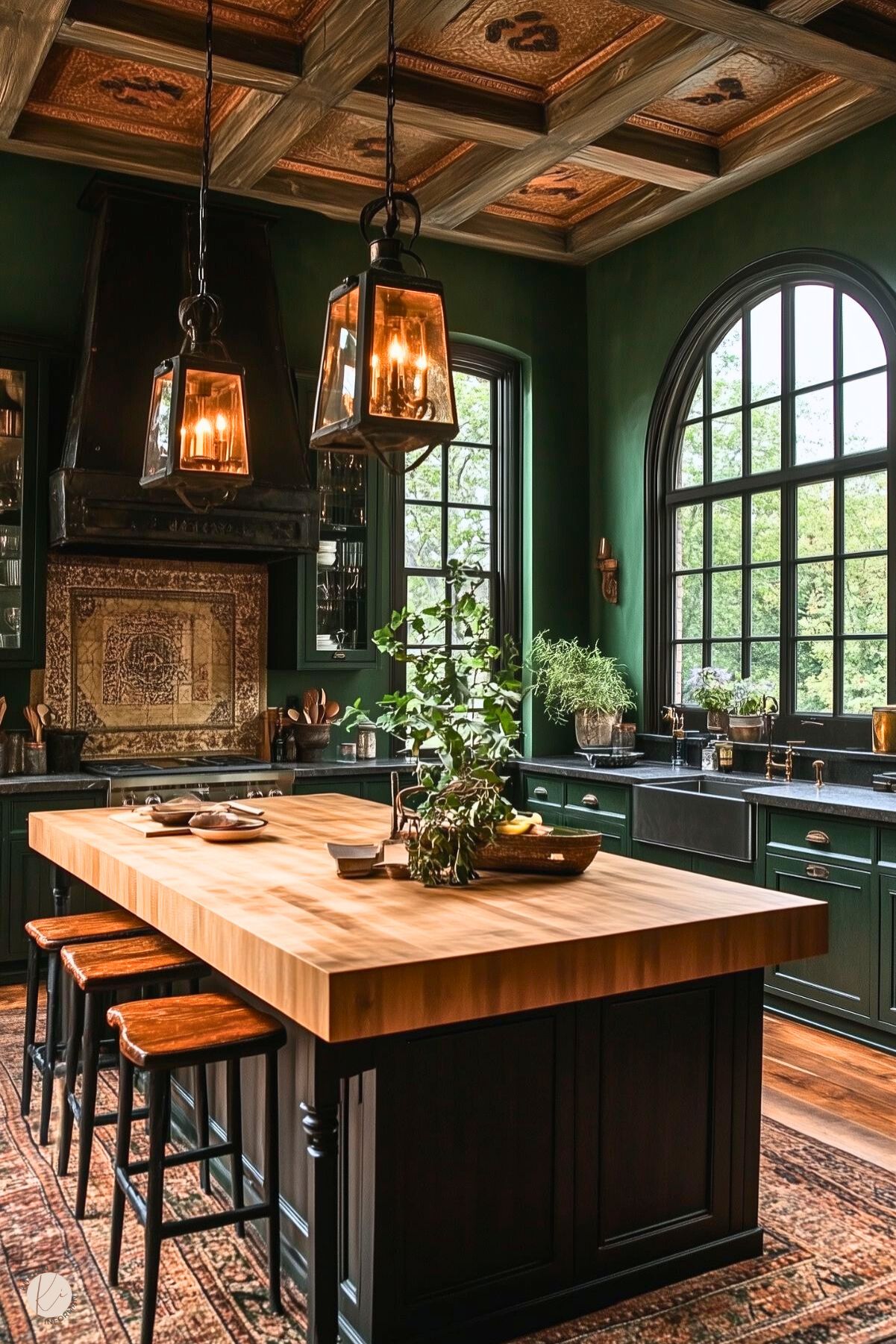
Green is a versatile color that can create various moods and styles in kitchen design. It is often associated with nature, freshness, and tranquility, making it an excellent choice for a space where people gather.
Psychology of Green Color
Green is linked to feelings of calm and balance. It often evokes a sense of nature and renewal. This connection can make kitchens feel more inviting and pleasant.
Using green can enhance creativity and promote relaxation, making it a great choice for cooking and socializing. Darker shades, like emerald, can add sophistication, while lighter shades, such as sage, give a more airy feel.
Incorporating green can also stimulate appetite, an important aspect for kitchens where food is prepared and enjoyed.
Shades of Green
Choosing the right shade of green is essential. Popular options include:
- Sage: A soft, muted green that pairs well with white and natural wood.
- Olive: A warmer, earthy tone that offers a traditional feel.
- Mint: A bright, fresh shade that brightens up space.
Dark greens like forest or emerald can create a dramatic effect, especially when used for cabinets or accent walls. Each shade offers a different vibe, helping homeowners express their personal style.
Color Pairing Essentials
Pairing green with the right colors can elevate a kitchen’s look. Some excellent color combinations include:
- White: Offers a clean and modern contrast, making green pop.
- Gray: A neutral that balances out the boldness of green.
- Brown: Adds warmth, especially with wooden elements.
Accent colors like gold or brass can add elegance and sophistication. Combining green with natural materials like stone or wood also enhances the organic feel.
Planning Your Green Kitchen
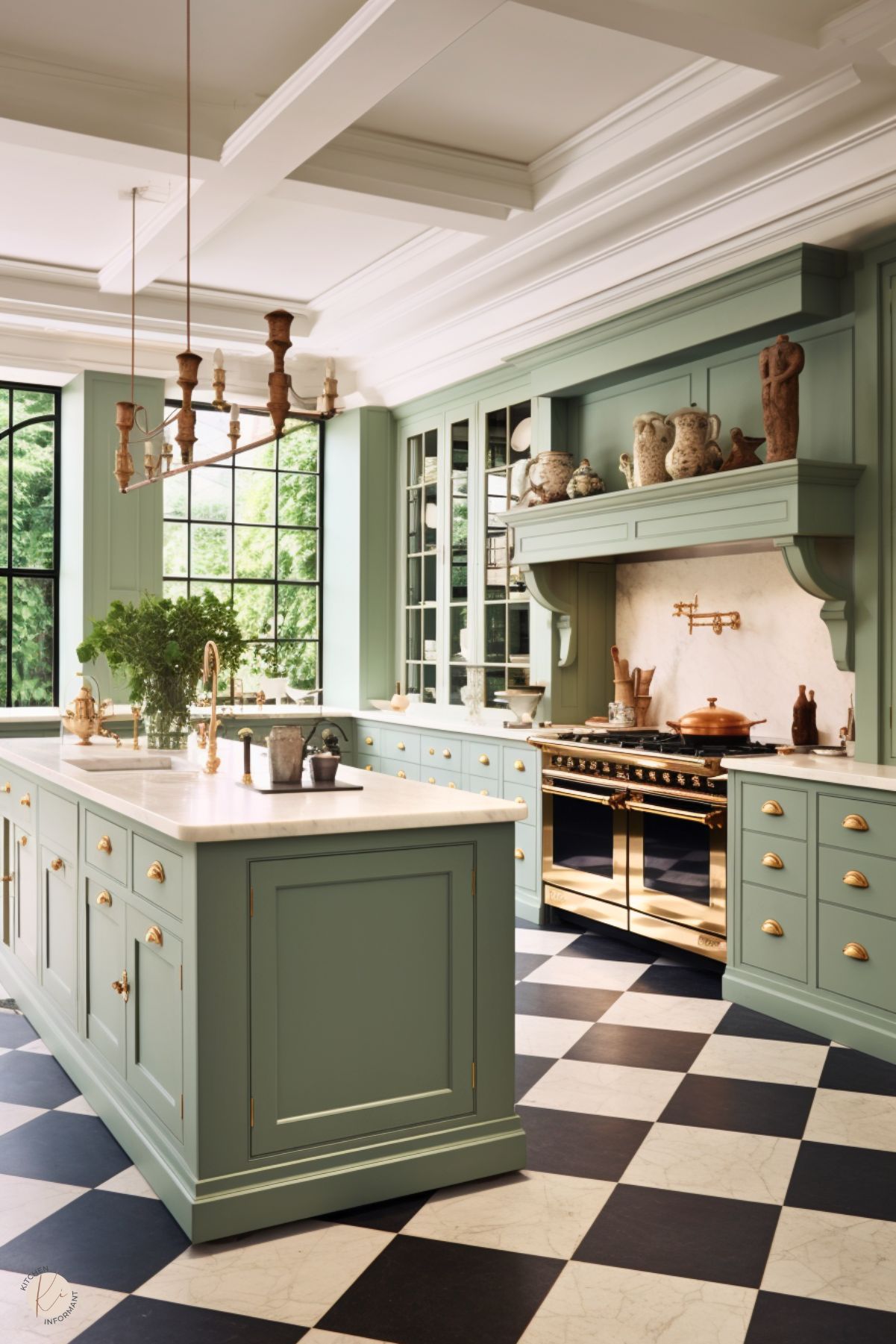
When planning a green kitchen, it’s important to think about space, lighting, materials, and layout.
Each of these factors plays a significant role in creating a beautiful and functional area.
Assessing Space and Lighting
Start by measuring the kitchen space. Knowing the dimensions helps in selecting the right size cabinets, appliances, and fixtures.
Consider where natural light comes from. A kitchen with ample sunlight can make green shades appear more vibrant.
Arrange for additional lighting, like pendant lights or under-cabinet lighting, to highlight the green elements. Combining natural and artificial light can create a warm and inviting feel.
Taking stock of windows and doorways also helps in determining how to use the space effectively without overcrowding it.
Choosing the Right Materials
Selecting materials that complement the green color is essential. Look for cabinetry, countertops, and flooring that either match or contrast well.
For example, wooden floors can provide a lovely warmth next to green cabinetry. A light-colored countertop can brighten up darker green shades.
Consider paint finishes too. Matte finishes can create a softer look, while glossy finishes can add a modern touch.
Also, explore eco-friendly materials. Bamboo or reclaimed wood can align with a green theme while being sustainable.
Layout Considerations
The kitchen layout should encourage easy movement and workflow. The classic “kitchen work triangle” helps in designing a space where the sink, stove, and refrigerator are in close proximity.
Incorporate an island if space allows. It can serve as both additional prep space and a casual dining area.
Think about storage needs as well. Utilizing vertical space with tall cabinets or open shelving can maximize storage while keeping the green color as a focal point.
Lastly, ensure there’s enough room for dining or entertaining, making the kitchen a welcoming space for everyone.
Green Kitchen Styles
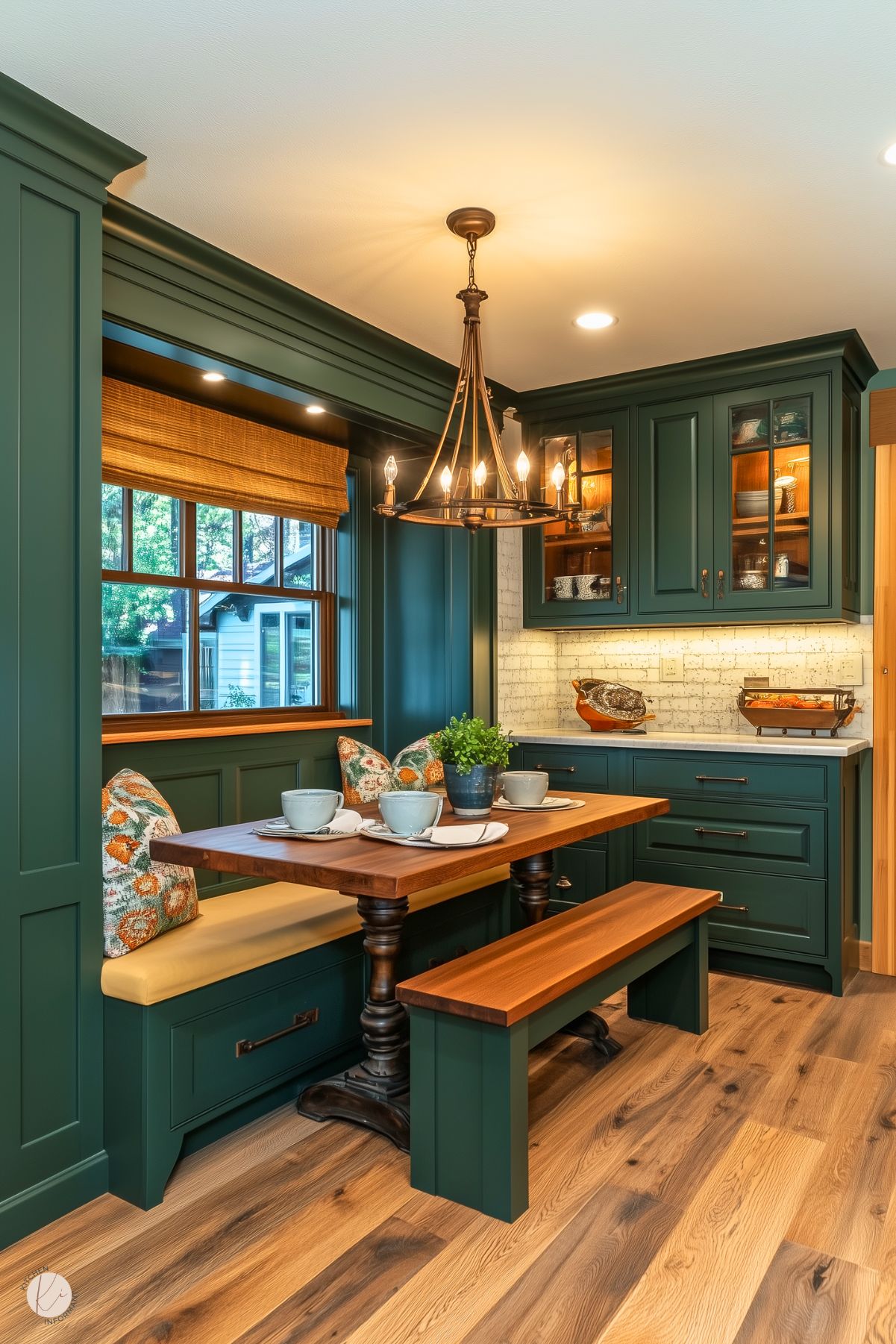
Green kitchens come in a variety of styles, each with its own unique charm and appeal. From sleek modern designs to cozy rustic looks, there is a green kitchen style to suit every taste and home.
Modern and Contemporary
Modern green kitchens embrace simplicity and clean lines. They often feature shades like mint or deep emerald. These kitchens usually incorporate materials such as stainless steel and quartz.
Cabinets in a glossy finish can enhance the sleek look. For added flair, open shelving lets vibrant dishware shine against the green backdrop.
Lighting plays a key role; pendant lights can add a stylish touch. A blend of greenery, like plants on countertops, brings freshness and life to the space.
Rustic Farmhouse
Rustic farmhouse kitchens use warm, earthy tones of green to create a cozy atmosphere. Shades like sage or olive green work perfectly with natural wood finishes.
Reclaimed wood cabinets and open beams can add to the rustic feel. A large farmhouse sink complements the aesthetic, making it functional and stylish.
Accessories like vintage cookware and woven baskets can enhance this style. Textures are important too. A mix of materials, such as metal and fabric, creates a comfortable, inviting kitchen.
Classic and Traditional
Classic and traditional green kitchens often feature deeper shades of green. Forest green or hunter green are popular choices. These colors pair beautifully with white or cream-colored accents.
Traditional cabinets often have detailed craftsmanship, giving them an elegant look. Crown molding and raised panel doors are common features in these designs.
A classic tile backsplash can enhance the traditional feel. Adding ornate hardware can provide a finishing touch.
This style combines gracefulness with character, making it ideal for those who appreciate timeless design.
Green Cabinetry and Countertops
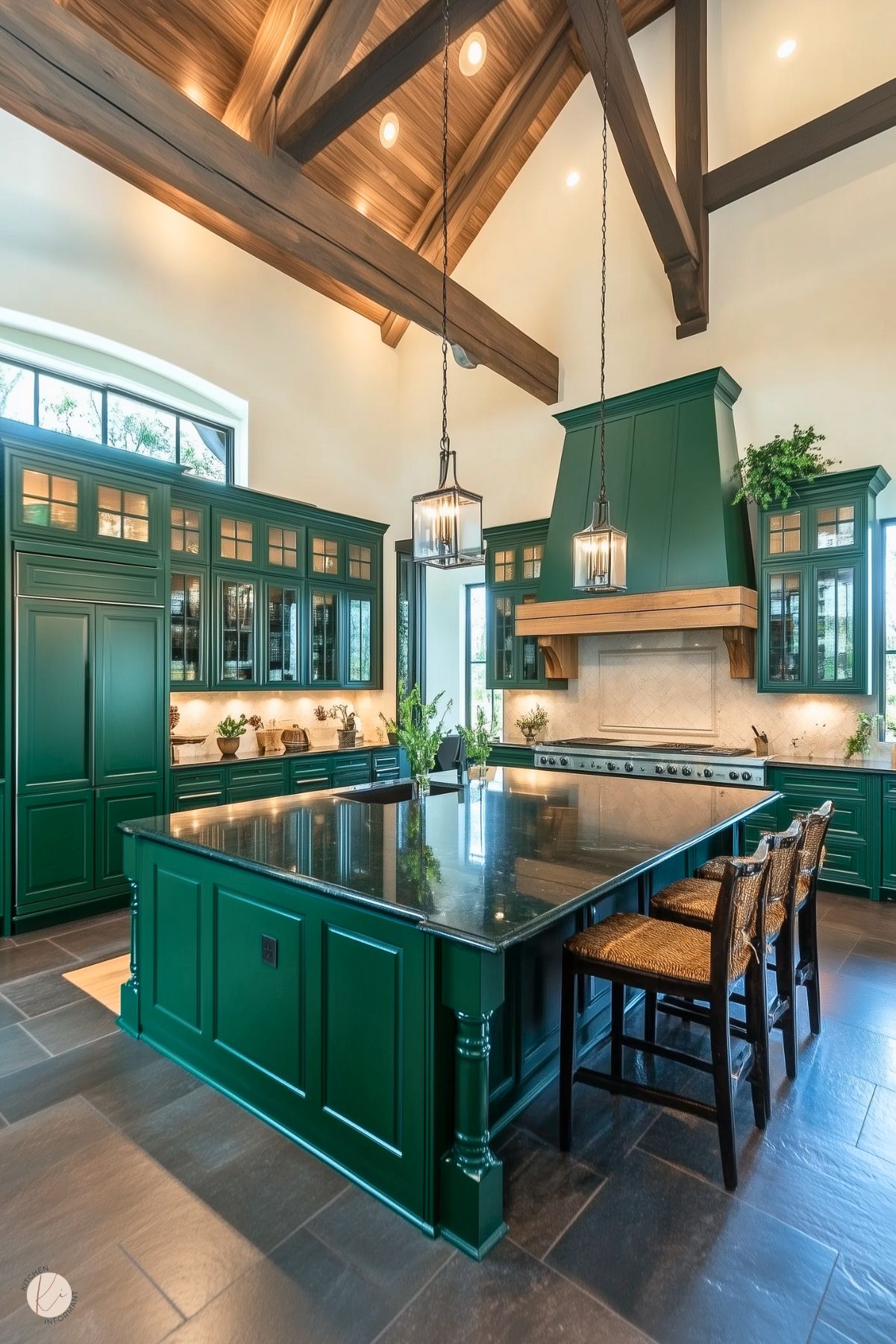
Green cabinetry offers a refreshing and stylish look in any kitchen. Selecting the right finishes, hardware, and countertops can elevate the design and functionality of the space.
Cabinet Finishes and Hardware
When choosing cabinet finishes, there are various shades of green to consider. From soft pastel greens to bold emeralds, the color can influence the kitchen’s atmosphere.
Popular finishes include matte, glossy, and textured. Matte finishes offer a modern feel, while glossy surfaces can bounce light and create brightness. Textured finishes add depth and interest to the cabinetry.
For hardware, options like brass, matte black, or brushed nickel can complement green cabinets beautifully. Mixing finishes can add character to the kitchen without overwhelming the design.
Countertop Material Options
Countertops in a green kitchen can enhance the overall look. Choices like granite, quartz, or butcher block can work well with green cabinetry.
Granite offers natural beauty and durability. Its various colors and patterns can add depth to the kitchen.
Quartz is another popular option. It is non-porous, making it easy to maintain and hygienic.
Butcher block adds warmth and is great for those who love to cook. It pairs well with green tones, offering a nice contrast.
Selecting the right countertop material ensures the kitchen is both functional and stylish.
Backsplashes and Walls
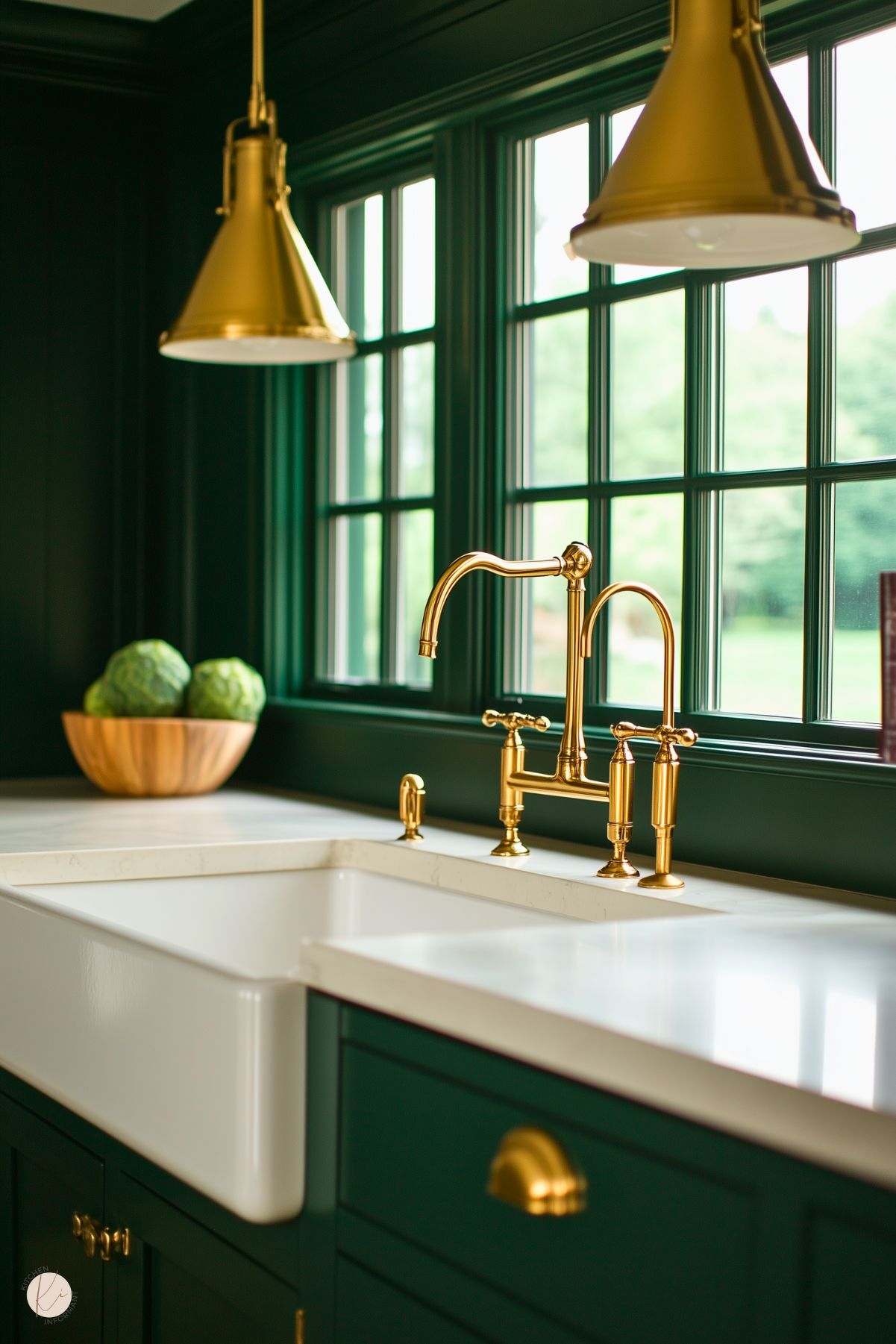
In a kitchen design, backsplashes and walls play a crucial role in enhancing the overall look.
Green colors can add freshness and vitality, creating a welcoming atmosphere. Different materials and styles can be used to bring life to kitchen spaces.
Tiling and Patterns
Tiling is a popular choice for backsplashes. It offers endless design possibilities. When using green tiles, one might consider options like glossy subway tiles or matte finishes.
These tiles can introduce texture and shine, making the kitchen feel brighter.
Patterns can also add interest. For instance, using mosaic tiles in various shades of green can create an eye-catching focal point.
A herringbone pattern or stacked layout can elevate the design further. Pairing these tiles with neutral countertops allows the green to stand out even more.
Wall Paint and Treatments
Paint is another excellent way to incorporate green into a kitchen. Soft shades like sage or mint can create a calm and inviting atmosphere. This color choice works well with white cabinets and wooden accents.
Adding wallpaper with green patterns is an alternative. Textured wallpaper can bring warmth and character to the space.
Another option is using peel-and-stick treatments, which are easy to apply and change.
Using green on the walls gives flexibility to change other elements later. It enables one to experiment with décor items or kitchen accessories while maintaining a cohesive look.
Decor and Accessories
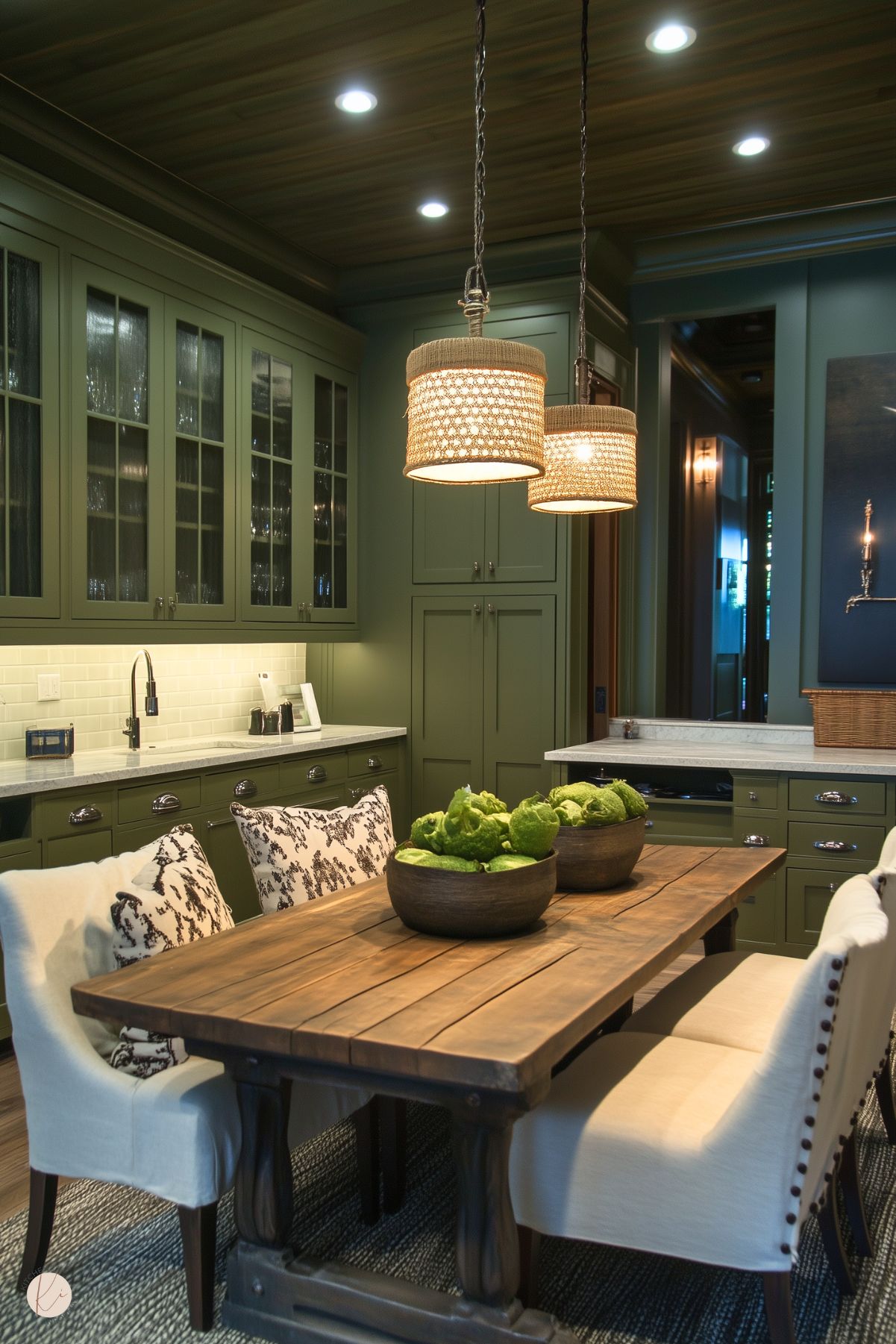
Choosing the right decor and accessories is essential for enhancing a green kitchen design.
These elements not only add personality but also create a soothing atmosphere that can energize the cooking space.
Selecting Decor Pieces
When selecting decor for a green kitchen, it’s important to choose items that complement the green tones.
Wall art featuring botanical themes can create a relaxing vibe.
Meanwhile, decorative bowls and vases in similar shades, like mint or olive, can tie the look together.
Textiles also play a key role.
Kitchen towels, curtains, and placemats in patterns that incorporate green can enhance the theme.
For lighting, fixtures such as pendant lights with green accents can make a bold statement.
Choosing decor that reflects individual style while maintaining a cohesive look is essential for a stunning green kitchen.
Incorporating Plants and Herbs
Bringing plants and herbs into a green kitchen design adds both style and functionality.
Herb pots are practical and beautiful. Meanwhile, fresh basil, rosemary, and thyme can be placed on windowsills or countertops, providing easy access for cooking.
Indoor plants like pothos or ferns thrive in kitchens and can improve air quality.
They should be chosen based on light availability and care requirements.
Hanging plants can also add visual interest.
Utilizing wall-mounted planters not only saves counter space but also creates a unique focal point.
Adding these natural elements enhances the kitchen’s ambiance while promoting a fresher and more vibrant cooking environment.
Appliances and Fixtures
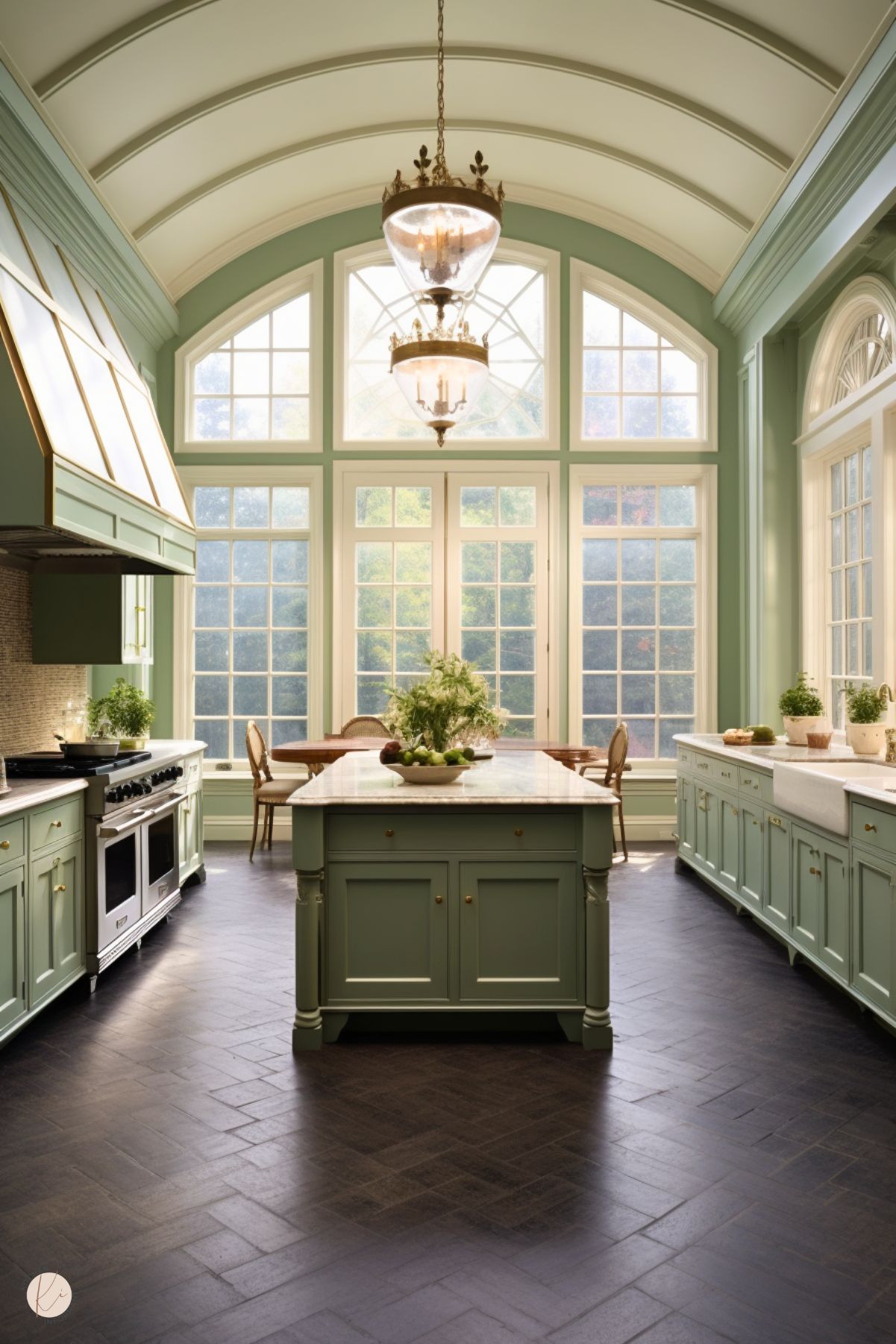
Choosing the right appliances and fixtures can greatly enhance the look and functionality of a green kitchen.
Integrating Appliances
When selecting kitchen appliances, options in green hues or finishes can add a cohesive touch.
Major appliances like refrigerators and ranges often come in various colors. Choosing ones in subtle shades of green or stainless steel can help blend with green cabinetry.
It’s also helpful to consider energy-efficient models.
They not only support sustainability but can save on utility bills.
Some brands offer eco-friendly appliances that fit a modern aesthetic.
Highlighting appliances as focal points or integrating them into cabinetry can provide a seamless look.
Fixture Styles and Finishes
Fixtures are another key element in a green kitchen.
Sink and faucet designs in brushed nickel, matte black, or even earthy greens can complement kitchen colors.
Choosing fixtures with both form and function is essential.
Lighting fixtures should also align with the kitchen’s style.
Pendant lights in natural materials like wood can warm up a green palette.
Meanwhile, choosing LED bulbs can enhance energy efficiency, creating a bright yet inviting atmosphere.
Mixing different styles can add character, while maintaining a balanced overall look.
Lighting Design
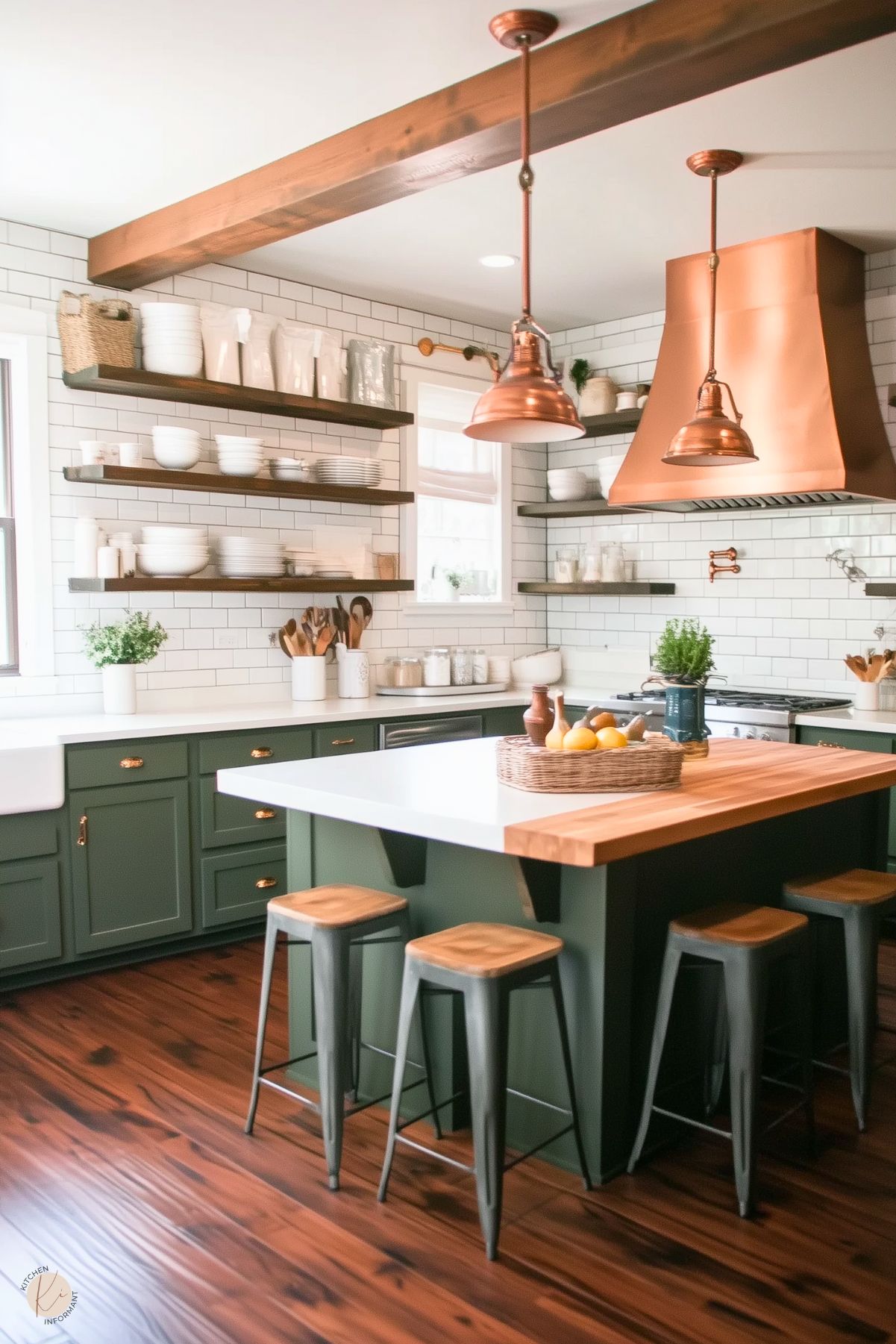
Choosing the right lighting design is essential for a green color kitchen.
Proper lighting enhances the beauty of green hues and ensures the space is functional and inviting.
Effective lighting includes task, ambient, and accent types, each serving a unique purpose.
Task Lighting
Task lighting is critical for areas where activities occur, such as preparing meals or reading recipes.
Under-cabinet lights are a popular option, providing direct light to work surfaces without harsh shadows.
Recessed lighting is another effective choice, allowing light to spread evenly across the entire countertop.
Meanwhile, adjustable fixtures can be positioned where needed most, ensuring functionality.
It’s also important to consider the color temperature.
Warmer tones around 2700K to 3000K work well with green colors, creating a cozy atmosphere while making food preparation easier.
Ambient Lighting
Ambient lighting sets the mood and main illumination for a kitchen.
Ceiling fixtures, such as chandeliers or pendant lights, can highlight the green tones in the room effectively.
Choosing fixtures with glass or matte finishes can diffuse light gently, providing an even glow.
Additionally, skylights or large windows can maximize natural light during the day, enhancing the kitchen’s overall brightness.
Using dimmers on ambient lighting gives flexibility, allowing the space to transition from bright and functional to warm and inviting for gatherings.
This variety caters well to different moments in the kitchen, enhancing the room’s charm.
Accent Lighting
Accent lighting adds depth and draws attention to specific features in a green kitchen.
Shelving with built-in lighting can showcase dishware or plants, highlighting the green elements beautifully.
LED strip lights beneath cabinets or along the toe kicks provide a subtle glow.
They enhance the room’s visual interest without overwhelming it.
Highlighting artwork or unique architectural features with spotlights can also create a focal point, enriching the kitchen’s design.
This additional layer of lighting allows the kitchen to feel more dynamic while complementing its green theme.
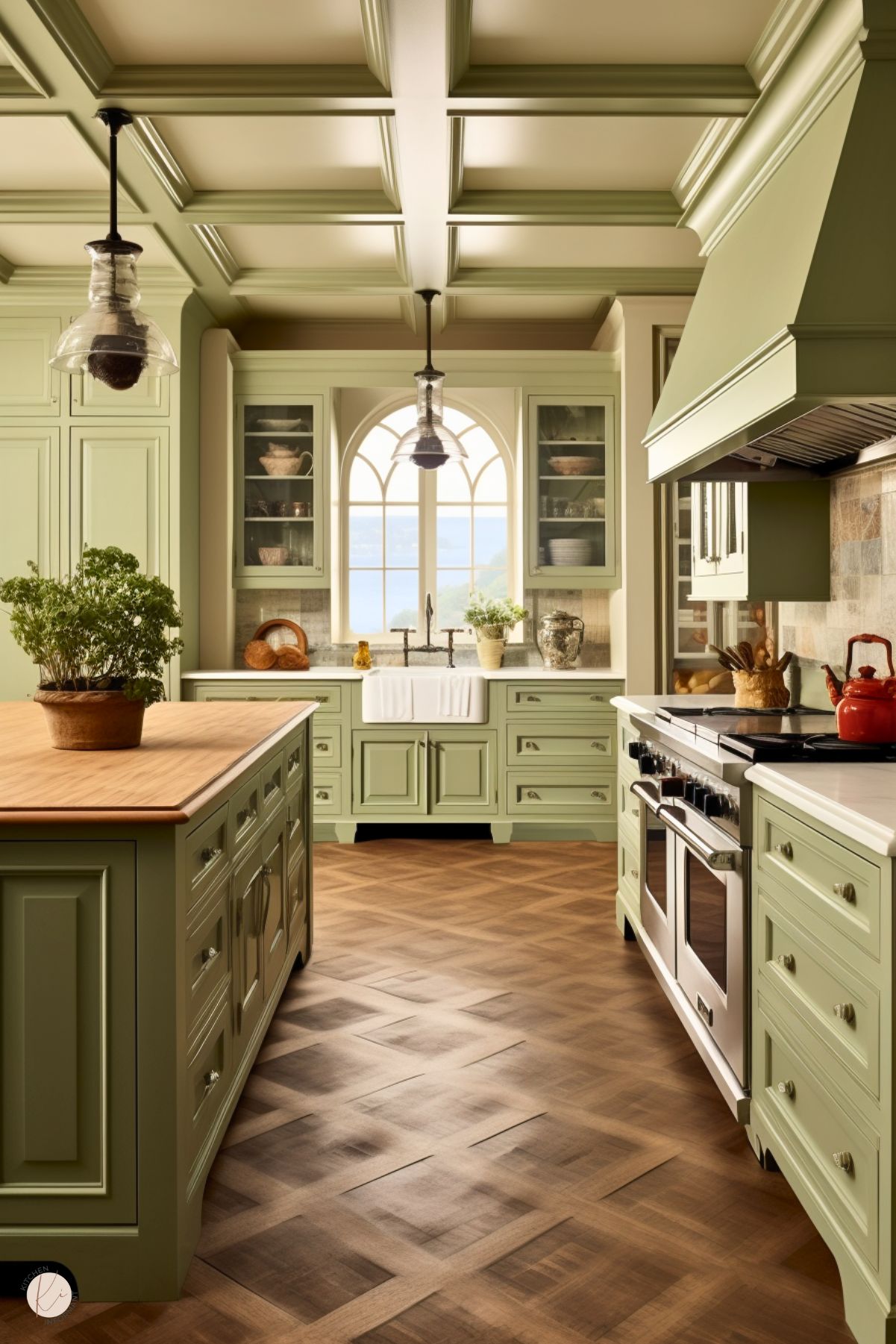
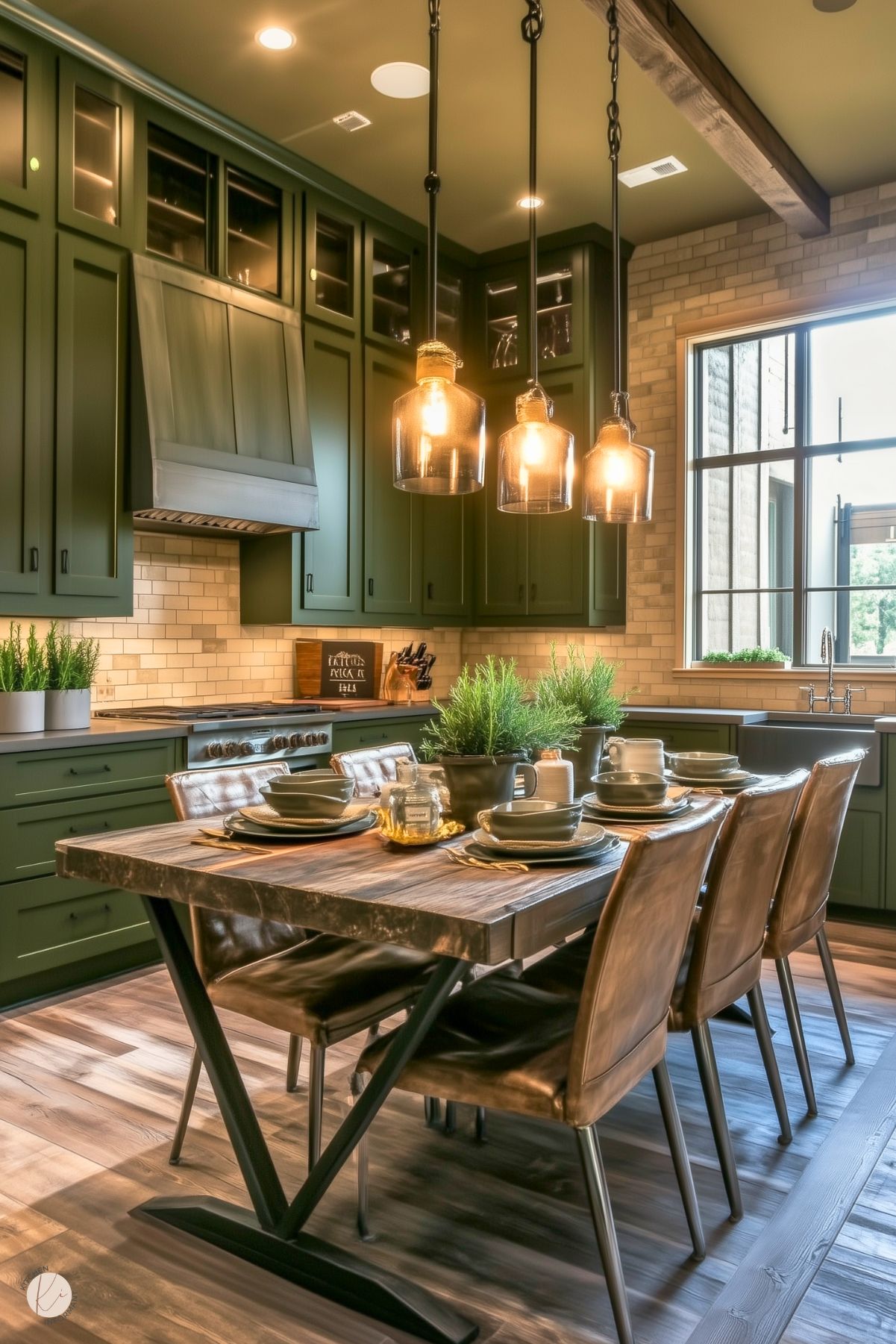
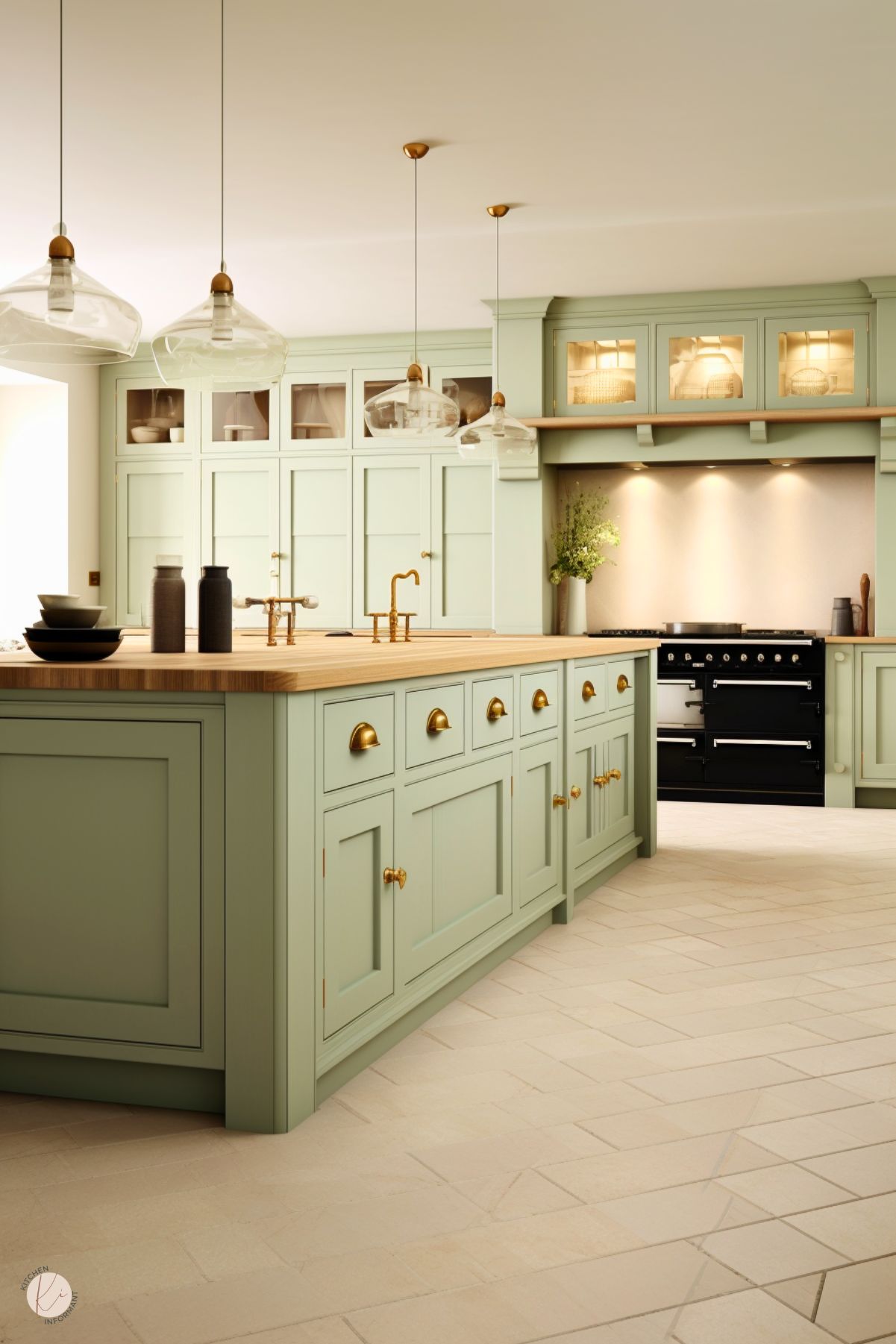
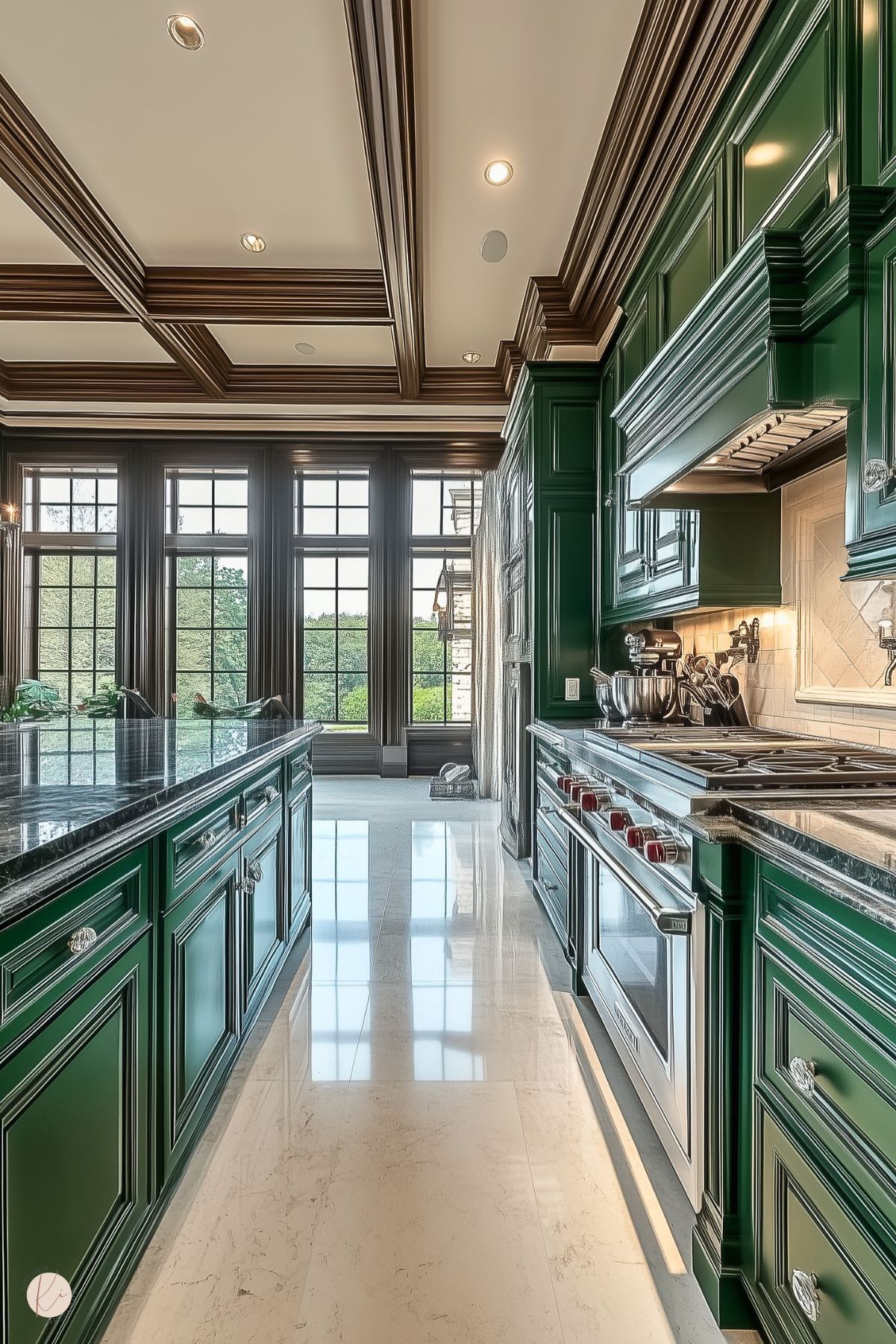
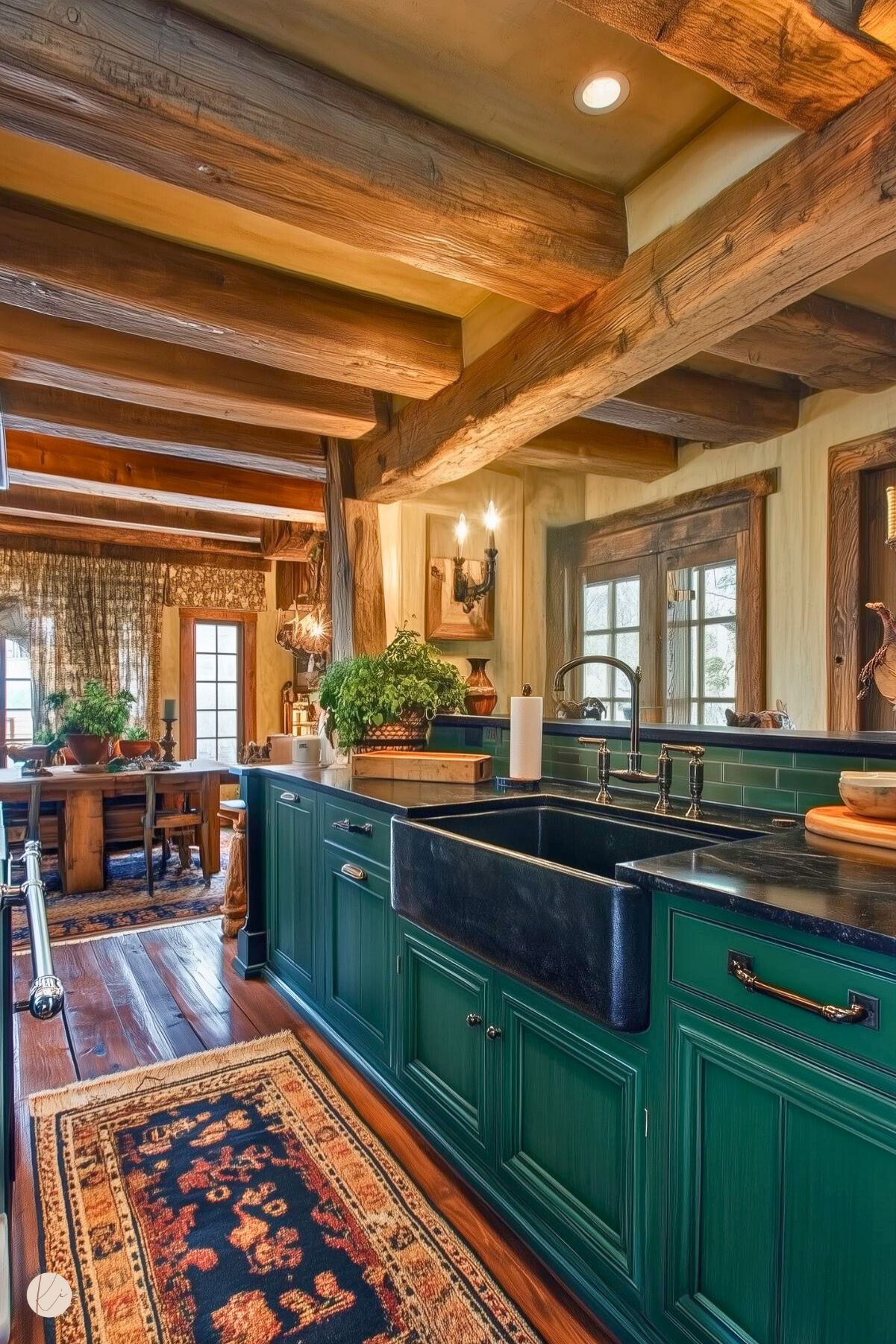
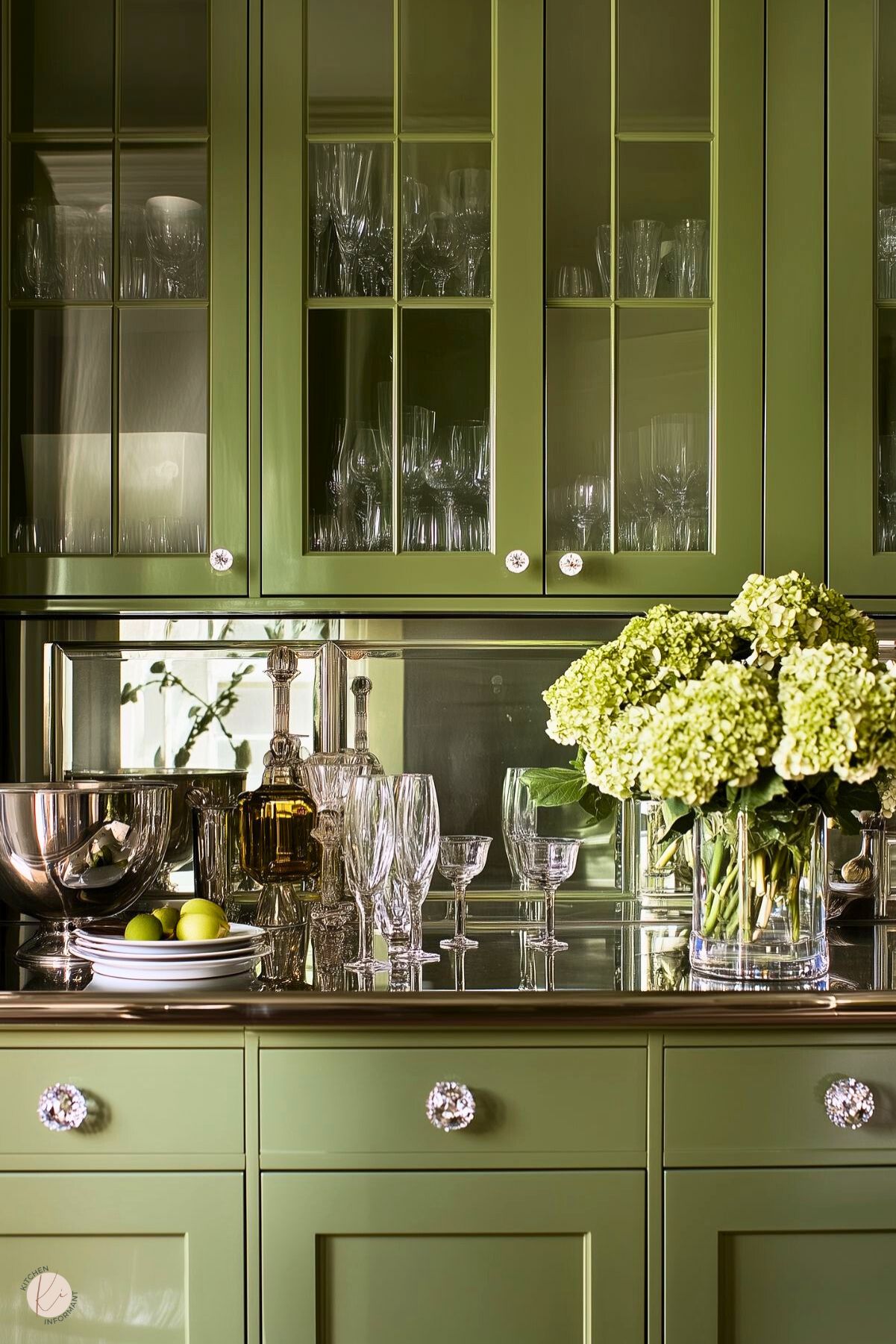
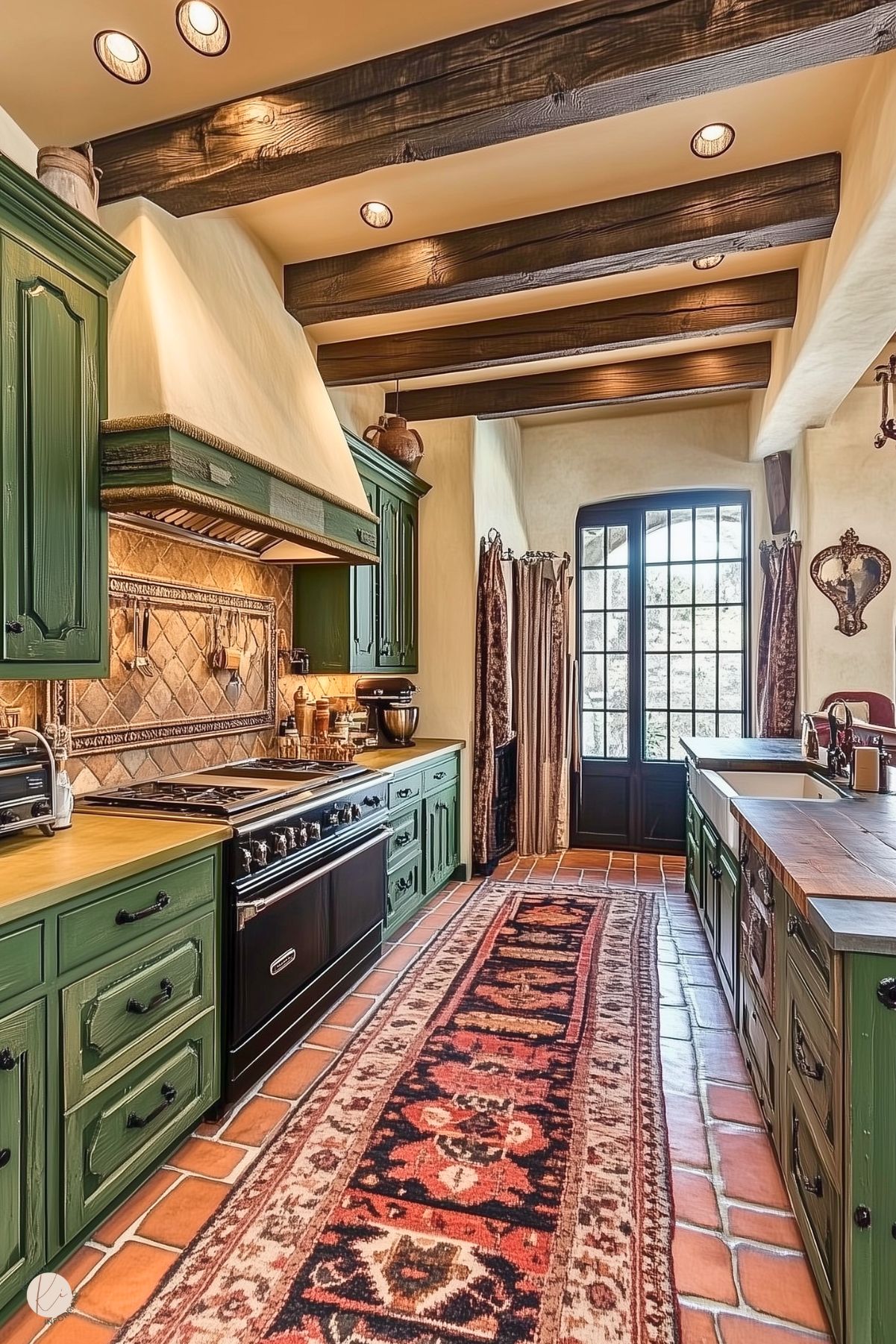
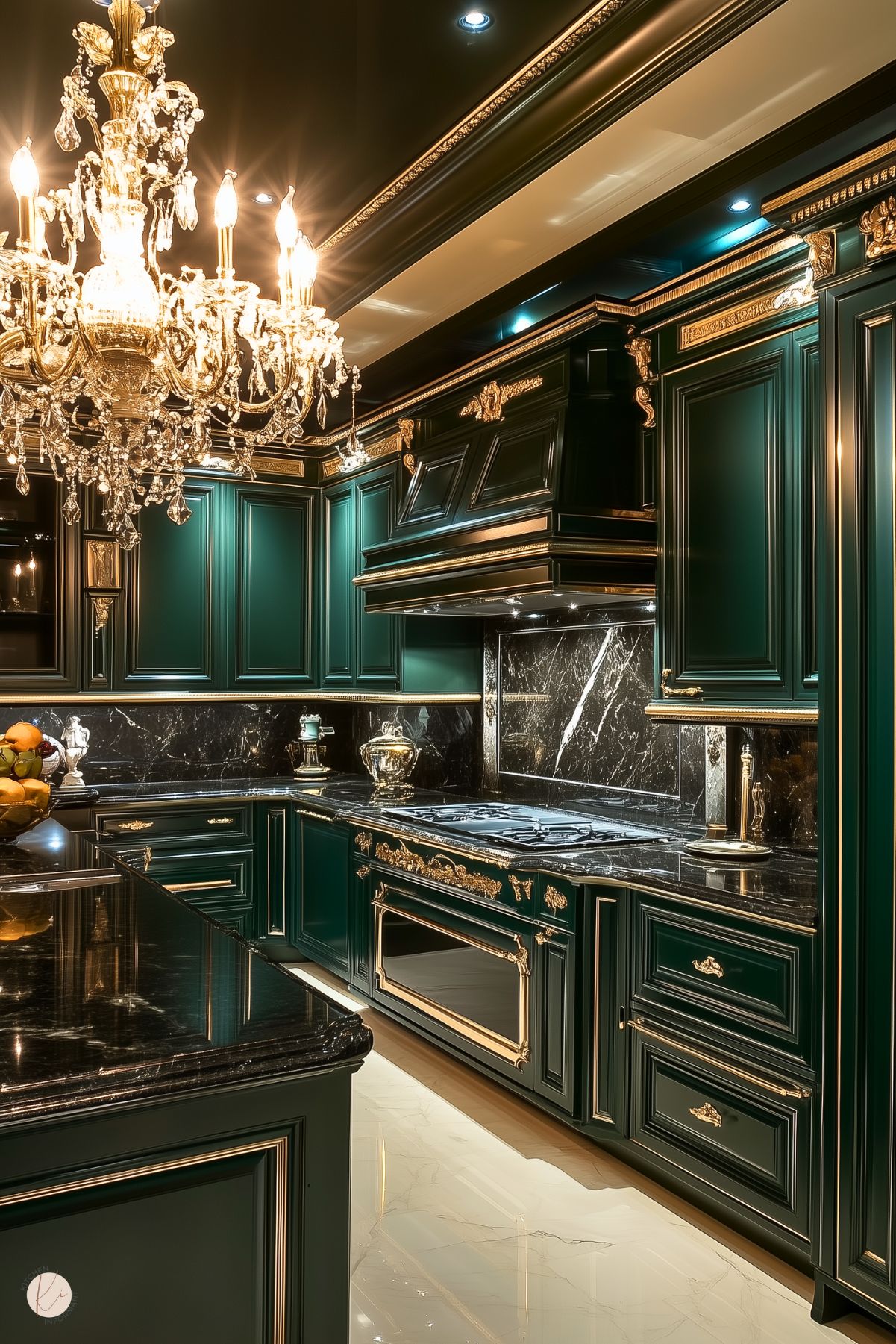
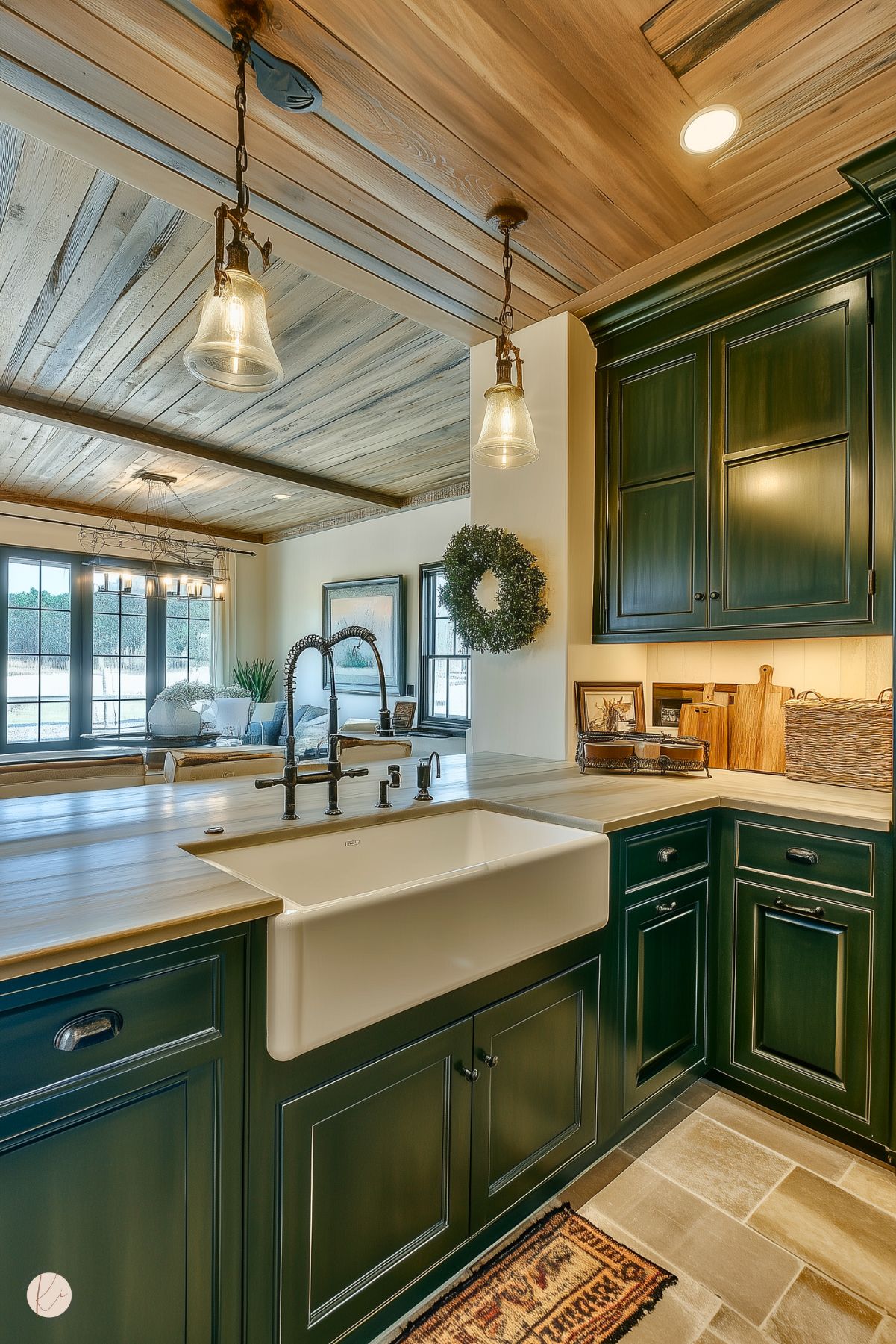
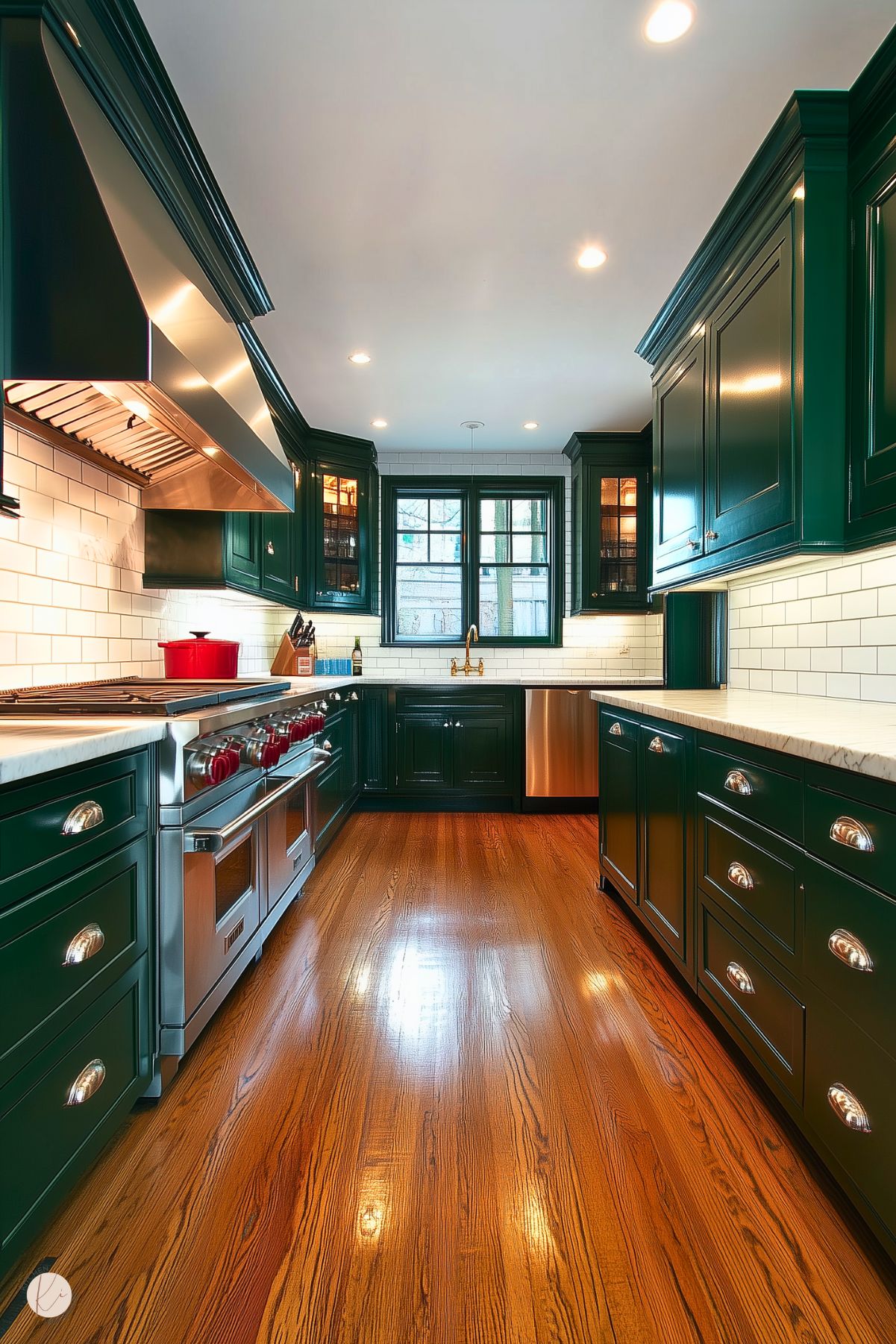
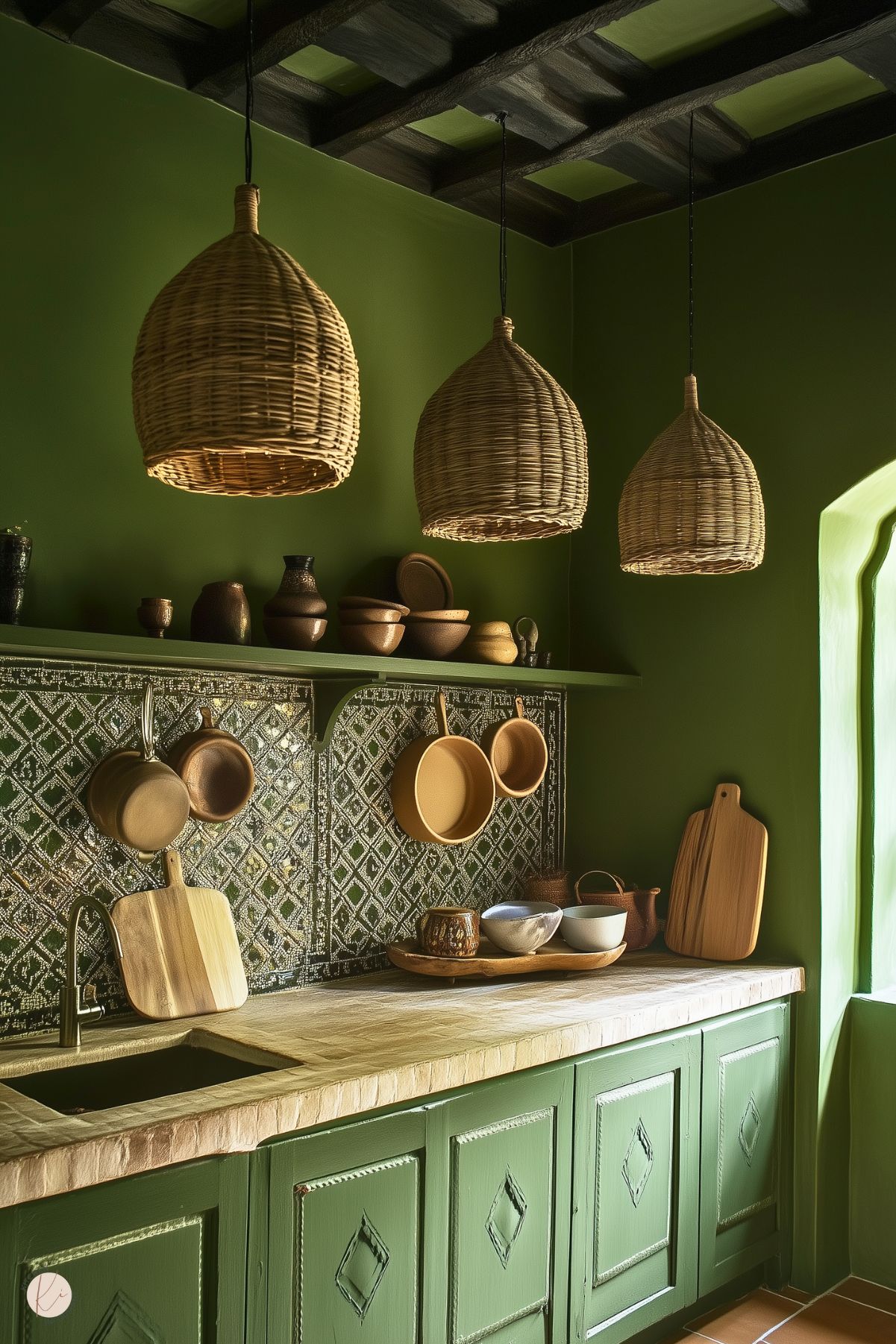
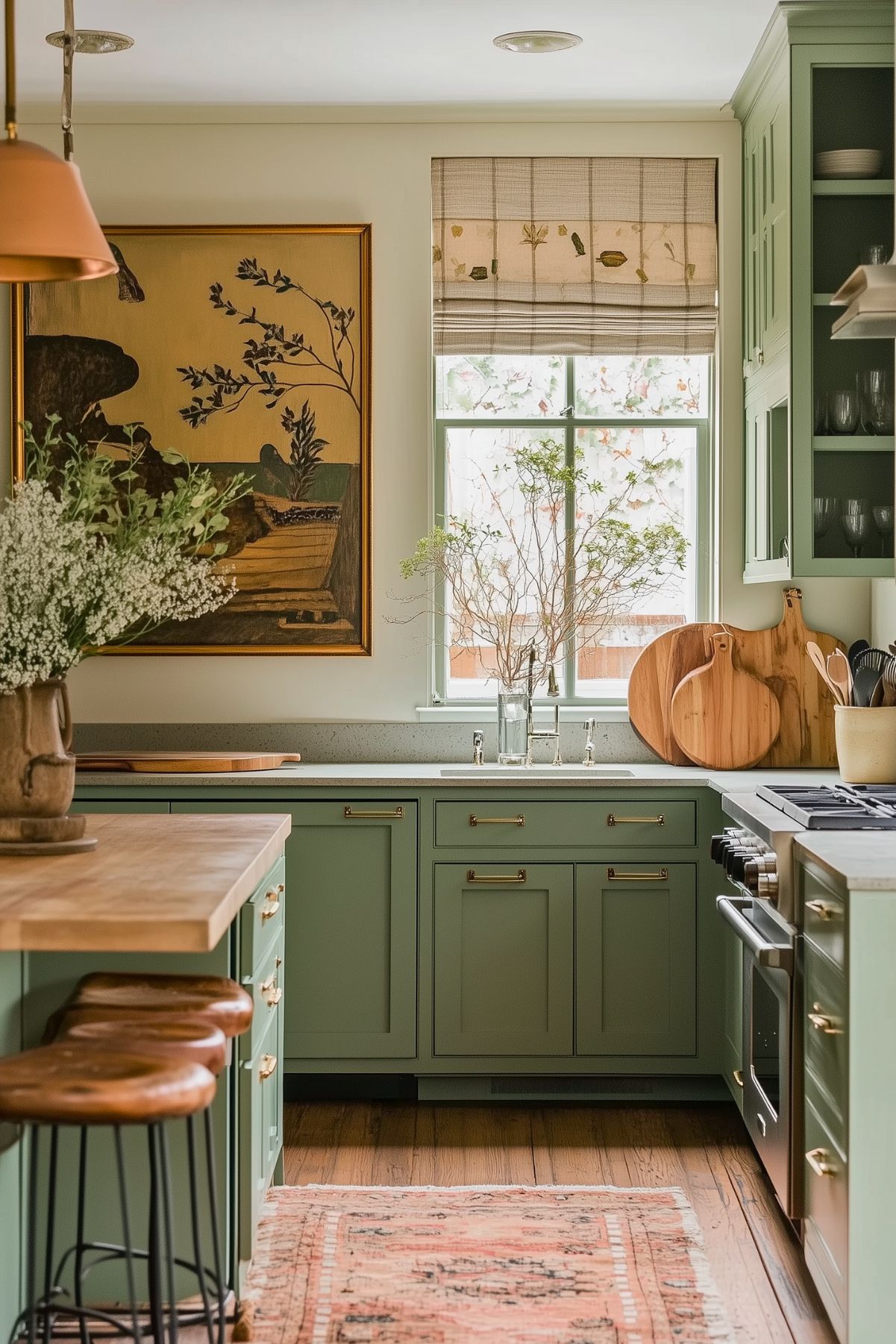
You May Also Like:
